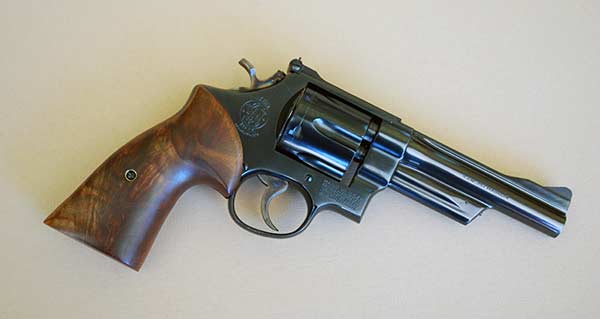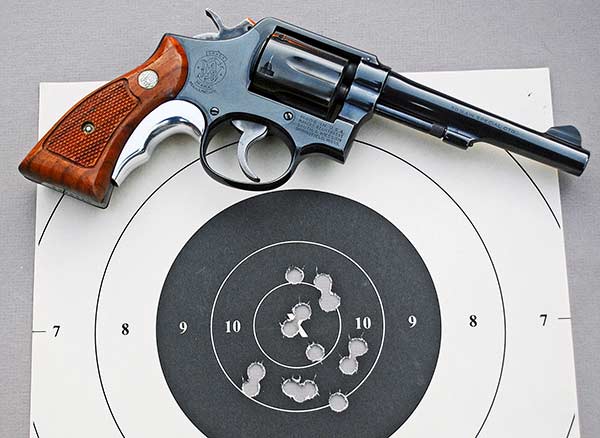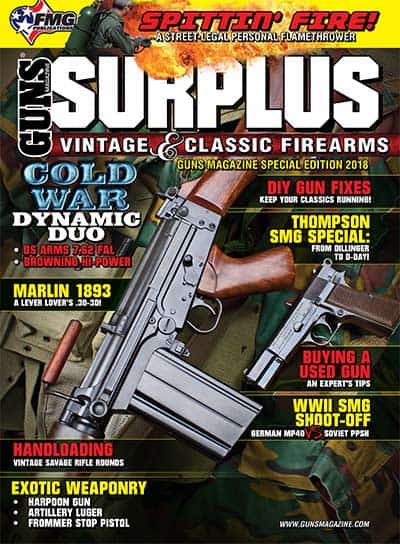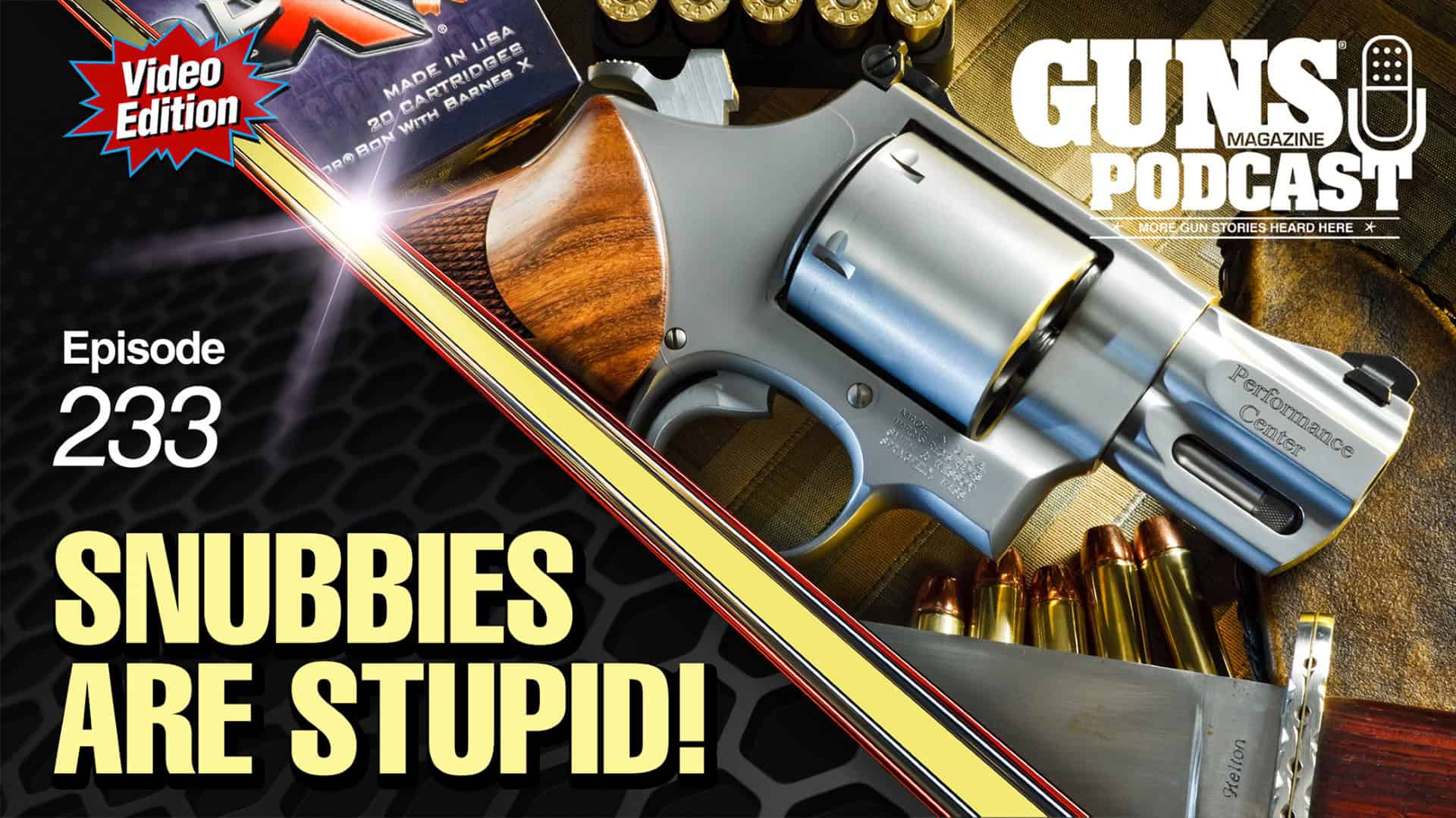The Classiest Of Classics
Why I love S&W revolvers — and why you should, too!
Unfortunately for my bank account, I like all types of handguns. I own numerous semi-autos and shoot them regularly in a bull’s-eye competition. Semi-autos have their place. And so do revolvers.
But this isn’t an argument for revolvers: If you’re reading this you probably enjoy them as much as I do. And we all have our favorites. I prefer Smith & Wesson wheelguns, particularly the post-World War II ones, up to about 1990 production. Nothing wrong with the newer guns; I just have a soft spot for S&W revolvers from the 1940’s on up through the 1980’s. I carried a .38 4″ (made in 1983) early in my cop career, shot others competitively in PPC and now enjoy shooting the older Smith & Wesson’s in retirement.

Skeeter Skelton’s favorite revolver, a 5" N-Frame .357, has a set of Herrett’s Roper style stocks in fancy walnut. This 5" 27-2 would be a great revolver for the one-gun shooter. Except for deep concealment, this S&W could do about anything a revolver shooter could ask as a range gun, hunter or home-defense weapon.
A Few Favorites
A K-Framed S&W revolver (a K-Frame is S&W’s mid-frame size) in .38 Spl. or .357 Mag. is usually in the gun box when I head out to the range. For the last couple of years, I’ve been shooting a 6″-barreled S&W M68, which was a limited production .38 Spl. made for the Los Angeles Police Department and the California Highway Patrol. My goal with the Model 68 was earning the NRA Distinguished Revolver Medal, which I was awarded late last year. This M68, purchased years ago at the LAPD Revolver Club, was a sentimental choice, grouping tightly with the required 158-grain lead ammo. I still shoot it weekly when I can and it’s become my go-to target revolver.
I’m also partial to the Military & Police (later renamed the Model 10 in 1957), especially the 3″–5″ barrel lengths. The M&P was the basis for many of the great revolvers S&W produced beginning in the 20th century. These old-timers, made before World War II, are slick and fun to shoot. Most any ancient Smith .38 built 90 years ago will hold its own accuracy-wise against a polymer pistol produced today.
The downside to shooting the pre-model-marked revolvers made before 1957 is not being able to use +P ammo in them. S&W recommends against shooting the pre-1957 guns with the jacketed +P duty-type ammo common today. I like the classic .38 factory 148-grain lead wadcutter load or 158-grain round nose moving along at standard velocity for almost all my range work. They’re easier on me as well as the gun during sometimes-long training sessions. The upside, besides light recoil to these standard loads, is the excellent accuracy you’ll get.
I carried a 3″ heavy-barreled .38 M10 as an off-duty gun toward the end of my police career, well after autos were authorized by my department. I never felt the need for an auto on the ride home after my tour of duty. The 3″ M10 is considered one of the great classic carry guns by S&W addicts. For a while in the 1980’s the .357 version (Model 13) was standard issue to FBI agents. Finding a minty one is becoming difficult and expensive; those that don’t end up in a collection become cherished concealed carry weapons.
Another M&P that I enjoy is the 5″ barreled M10. Easier to shoot well than the shorter (and more common) 4″, it carries and balances better than a 6″. Gun writer Skeeter Skelton considered a 5″ barrel ideal for a revolver carried as well as shot extensively. I think he was right about that. Skelton had several S&W 5″ N-Frame .357’s (the N-Frame is S&W’s larger frame, only superseded in size by the newer X-Frame) over his lifetime and considered it his favorite do-everything revolver. Fitted with a set of Herrett’s Roper-style stocks in fancy walnut, a 5″ Model 27 .357 Mag. is a fine revolver and can do just about anything you’d ask of a handgun, except deep concealment.
Personally I prefer the 6″ barrel length on the big N-Frames only because I use mine for hunting, usually from a stationary position. But if I was allowed only one handgun (perish the thought), a 5″ blued M27-2 would be a top contender for my lone pistola.

Three S&W classic stainless revolvers in Bob’s collection. The Model 66
(top) K-Frame is in .357 and is a classic. The center revolver is a Model 67
in .38 Spl., Bob’s first duty weapon on the LAPD. Last up is a little Model
649 Bodyguard in .38 Spl., which is a favorite daily carry handgun.
All three revolvers wear Pachmayr stocks.
J-Frames
Smith & Wesson manufactures some of the best concealment revolvers to be had. The little J-Frame 5-shooters have been around for over 60 years, starting with the Chief’s Special .38. I won a 2″ Model 649 Bodyguard .38 when I was on Probation and carried it off and on throughout my police years as a backup and off-duty weapon. Fitted with a set of Pachmayr “Compac” rubber grips, it rode in my pocket as a backup when I was in uniform. I still carry it now in retirement, swapping it out occasionally with another J-Frame, a 442 Airweight. Both revolvers are small enough for deep concealment, even in hot weather with just a T-shirt.
I bought the 442 when I went to Narcotics and packed it daily, also in my pocket, when purchasing rock cocaine from the LA gangsters I did business with. The 442 is very light because of the aluminum frame. It also has a completely enclosed lockwork that won’t allow the weird stuff inhabiting pants pockets into the innards of your gun. I wrapped sticky electrician’s tape on the grips, which helped keep the gun from slipping out of my pocket. It also kept it from looking like a cop’s gun if it had been spotted. The 442 was a totally reliable fighting handgun, never noticed, even in hot weather, until I needed it. I consider it (and its stainless/aluminum brother, the 642) one of the best deep-concealment handguns made.
Getting The “Right” Feel
If you’re going to shoot your Smith often, you’ll need to do something about the stocks. The walnut checkered ones on the older Smiths are collectible and pretty, but not very good if you plan on getting the most out of your gun. A grip adapter is a quick, easy and inexpensive fix to give you more gripping surface and prevent the revolver from twisting in your hand during strings of double action fire. Better yet is a set of rubber after-market stocks fitting your hand and absorbing recoil well. While not too attractive, they have a look some would call “functional.”
The best solution is to retain the original wood stocks for show-and-tell and head to the range with practical grips on your revolver. I like Pachmayrs, but there’s an almost infinite variety of stocks, both wood and synthetic, to fit your handgun. The fun part is deciding what will work for you. Experimentation is your friend. If you like wood, Herrett’s might be the way to go with both mass-produced and custom hand-fitted stocks. They look great as well as give you the control you’ll need to shoot well.
What about action tuning? Unless the revolver is not within factory specs, I prefer to leave mine close to “stock.” Many shooters think a light trigger pull is a good trigger. Remember, smooth is good; really light maybe not. If your revolver “carries-up” or indexes properly, has minimal end-shake (front to back movement) and has no ignition issues, leave it alone and shoot it. Excellent scores come from regular practice, not super-tuned, tricked-out guns. As you get better you’ll form your own ideas on what you need in your revolvers. And that’ll change as you gain experience.
There are other revolvers that will serve you well besides a slick S&W and you’ll get no argument from me about it. We’re lucky we, as American shooters, have such a large range of choices in handguns. Due to my background and experience, Smith & Wessons have worked well for me. Luckily, there were millions produced with plenty of gently used ones on the second-hand market to keep my addiction fed. I’ll continue using my other revolvers and semi-autos, but a Smith & Wesson revolver or two will usually be around for practice, the next match or carried as my defensive handgun. Yeah, I like ’em.
For more info:
www.smith-wesson.com
www.bkgrips.com
www.herrettstocks.com
www.lymanproducts.com
SIG SAUER Elite Performance Ammo
SIG SAUER, famous for their semi-auto pistols, is now out with its own ammunition line, manufactured in a newly opened facility in Arkansas. I picked up a couple of boxes of their 125-grain jacketed hollow point .357 Mag. ammo, hoping it would be a good fit accuracy-wise in my S&W 66. The bullet itself is SIG’s new propriety V-Crown design, which has a very wide opening in the hollow point to ensure reliable expansion.
I checked with the SIG ballistics engineers regarding the published velocity of 1,450 feet per second. I was told their velocity averages were obtained using a 6″ unvented test barrel, which means your actual velocity is going to be closer to 1,300 fps in a 4″ revolver. That’s fine and well within the magnum velocity norms for this bullet weight.
Several cylinders of the new SIG .357 Mag. ammo went through my stainless S&W 66 without any issues. It’s quite accurate; a 10-shot string at 50 yards over a sandbag rest grouped into 2.4″, easily making my .357 a deer slayer at that yardage. At 25 yards it cut one ragged hole to point of aim without adjusting the rear sight. This would be a great load for small- to mid-sized game or defensive use. Recoil is definitely there, but manageable. Fouling was minimal, and I like this load. I’ll be stocking up on some the next time I have a few coupons from Cabela’s.
For more info: www.sigsauer.com

















